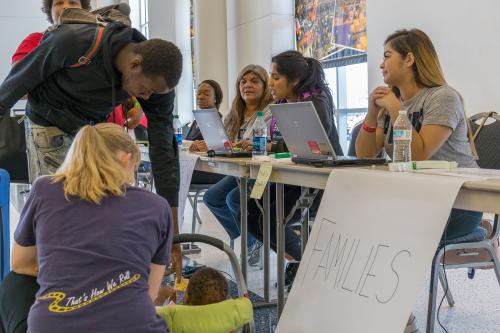Executive Summary
Census 2000 reveals that Detroit residents increased their income during the 1990s, but that the city still confronts harsh social, demographic, and economic realities at the turn of the 21st century.
Between 1980 and 2000, Detroit lost fully one-fifth of its population. For the first time since the 1920 census, the city’s population dipped below 1 million. Meanwhile, growth in the region during the 1990s occurred far from the core, as nearly every neighborhood in the city and its close-in suburbs lost residents. To be sure, Detroit actually gained Hispanic residents in the last decade, many of them new immigrants from Mexico. But at the same time it lost over 100,000 white residents. Today African Americans make up more than 80 percent of the city’s population. Jobs also continued to shift outward in the Detroit metro area, and fewer than one-fourth of the region’s workers are now employed in the central city.
Nevertheless, residents of Detroit appear to have greatly benefited from the strong Midwestern economy of the late 1990s. Household incomes rose faster than in any of the 22 other Living Cities, and child poverty dropped by a stunning 13 percentage points. Homeownership also grew for most racial/ethnic groups. Despite this progress, significant challenges remain. Detroit ranks low among U.S. cities on median household income, and four in ten of the city’s families with children live below or near the poverty line. With such low incomes, many working families struggle to pay rent and save to buy a home; in many city neighborhoods today, a lack of market demand leaves senior citizens a majority among homeowners. Income growth in the future may be limited by the fact that only one in nine adults in the city holds a college degree.
Along these lines and others, then, Detroit in Focus: A Profile from Census 2000 concludes that:
- The Detroit metro area continued to decentralize in the 1990s amid slow growth region-wide. Between 1980 and 2000, the City of Detroit lost one-fifth of its population. During the same period, the region’s suburbs grew modestly, but the locus of that growth shifted far from the core. In the 1990s, a few neighborhoods in downtown Detroit gained residents, but population loss continued throughout the remainder of the city and in nearly all inner suburbs. Today, only 21 percent of Detroit-area residents live in the central city, and only 22 percent of the region’s workers are employed there—roughly half that in the average Living City.
- Detroit attracted modest numbers of immigrants, but African Americans make up the overwhelming majority of the population. The number of whites living in Detroit plummeted in the 1990s, and modest gains in Hispanic and Asian populations were not enough to compensate for these losses. By 2000, over 80 percent of the city’s population was African American, by far the largest proportion among the 23 Living Cities. The city did gain 11,000 immigrants in the 1990s, particularly from Mexico and Iraq, but Detroit’s suburbs added more than eight times as many foreign-born residents over the same period. In addition, the metro area remains highly stratified along racial and ethnic lines, with blacks largely confined to Detroit and its close-in suburbs to the north.
- Children, especially those in single-parent families, dominate Detroit’s population. Baby Boomers aged 35 to 54 are by far the nation’s largest age cohort. In Detroit, however, this distinction belongs to young children aged 5 to 9. In fact, people under the age of 18 make up a greater proportion of the population in Detroit (31 percent) than in any other Living City. Most of the city’s children live in single-parent households; more than a fifth of the city’s households are non-married families with children, but only one-eighth are married couples with children. Over the decade, Detroit attracted few newcomers, and the number of 25- to 34-year-olds living in the city dipped 15 percent.
- Incomes grew in Detroit during the 1990s, though the city remains home to a primarily low-wage workforce of all races and ethnicities. Detroit topped all other Living Cities in median household income growth over the decade (17 percent). The poverty rate dropped significantly, especially among children. However, Detroit still ranks 88th out of the 100 largest cities on household income. The number of middle-income households living in the central city declined over the decade, while the ranks of moderate-income “working poor” families grew. Detroit stands apart from other Living Cities in the extent to which low incomes are shared across all of its racial and ethnic groups—median incomes for white, black, Hispanic, and Asian households all lag the national average. Going forward, the low educational attainment of Detroit’s residents will likely limit the city’s future income growth—only 11 percent of them held a college degree in 2000.
- Homeownership increased for most groups in Detroit, but many renters struggle to afford housing. Fifty-five percent of households in Detroit own their own homes, an above-average rate among the 23 Living Cities. And homeownership has been on the rise for the city’s black households, 53 percent of whom now own. The weak housing market in many Detroit inner-city neighborhoods may have limited the economic benefits of homeownership, however. In many of these neighborhoods, the elderly represent a majority of homeowners. Rents in Detroit were stable over the decade, and in 2000 were second-lowest among the Living Cities. Yet even so, 60,000 Detroit renters still pay more than 30 percent of income on rent, suggesting that most earn too little to afford the modest rents that prevail throughout much of the city.
By presenting indicators like these on the following pages, Detroit in Focus: A Profile from Census 2000 seeks to give readers a better sense of where Detroit and its residents stand in relation to their peers, and how the 1990s shaped the cities, their neighborhoods, and the entire Detroit region. Living Cities and the Brookings Institution Center on Urban and Metropolitan Policy hope that this information will prompt a fruitful dialogue among city and community leaders about the direction Detroit should take in the coming decade.
The Brookings Institution is committed to quality, independence, and impact.
We are supported by a diverse array of funders. In line with our values and policies, each Brookings publication represents the sole views of its author(s).


